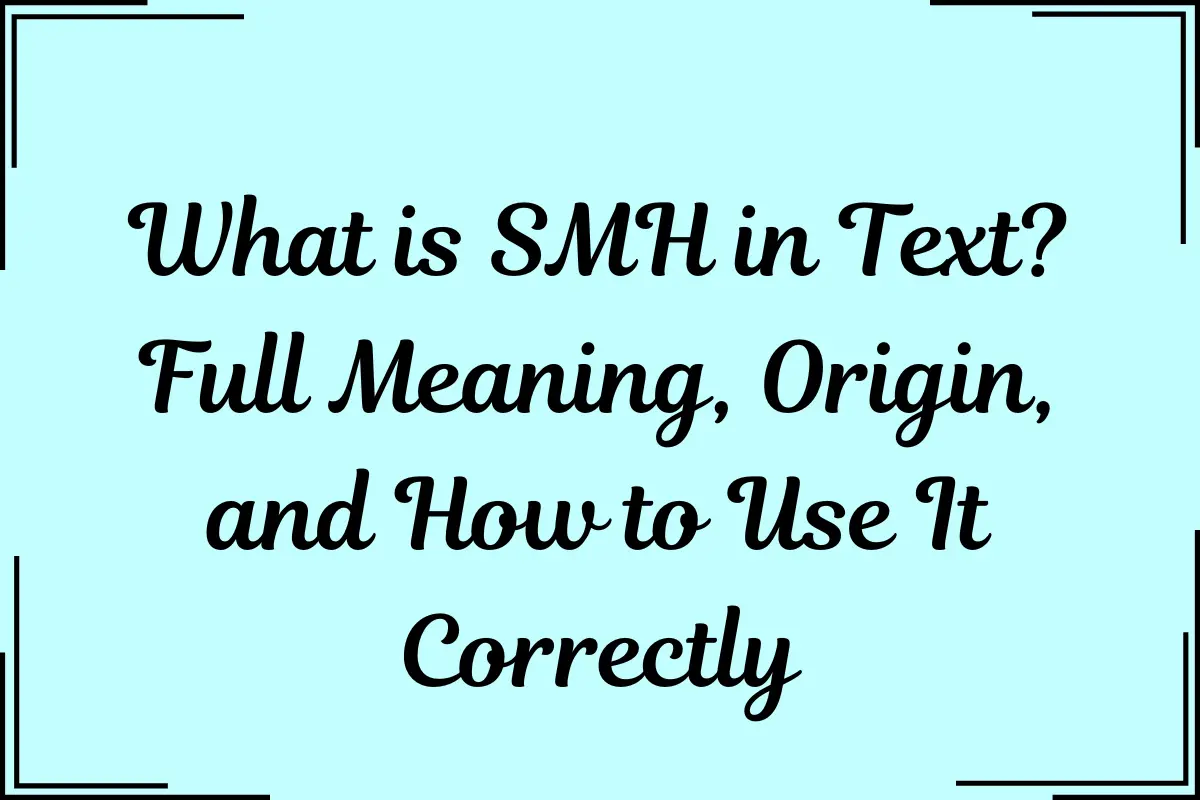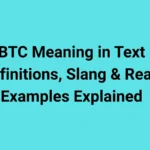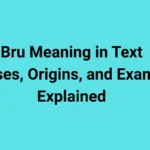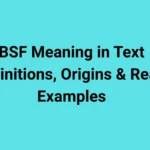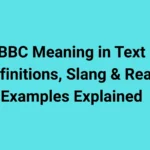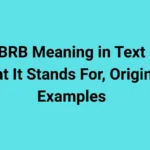Picture this: You’re scrolling through Instagram, and your friend comments on a photo, “SMH, I can’t believe you did that.”
Or maybe you’re texting someone, and they reply simply with “SMH.”
You stare at your phone wondering… Is that a compliment? A joke? An insult? Did I miss something?
Welcome to the world of internet slang, where three little letters can express an entire emotion.
In this guide, we’ll break down what SMH means in text, where it came from, how to use it correctly, and even how not to use it. We’ll cover real-world examples, pop culture references, and the dos and don’ts so you can confidently use SMH in your own conversations.
What Does SMH Mean in Text? 📱
SMH stands for “Shaking My Head.”
It’s used to show disappointment, disbelief, frustration, or sometimes playful teasing. Instead of typing a long sentence like “I can’t believe this” or “That’s ridiculous”, people simply write SMH.
It’s the digital equivalent of physically shaking your head in disbelief.
Quick Examples:
- “They forgot my order for the third time this week… SMH.”
- “He spent $500 on a video game skin… SMH.”
- “SMH at myself for leaving my phone at home.”
The Origin of SMH – From Chatrooms to Global Slang 🌍
The term SMH dates back to the late 1990s and early 2000s, when internet chatrooms like AOL Instant Messenger (AIM) and Yahoo Chat were popular.
Back then, people needed shortcuts to express feelings quickly, especially in fast-moving group chats. Acronyms like:
- LOL (Laugh Out Loud)
- BRB (Be Right Back)
- OMG (Oh My God)
- TTYL (Talk To You Later)
… became a part of online culture — and SMH joined the club.
Key moments in SMH history:
- Early 2000s: Used mainly in chatrooms and text messages
- 2007-2010: Gained massive popularity on Twitter due to character limits
- 2010s: Became common on Facebook, Instagram, and meme culture
- Today: Universally recognized, even outside of internet-heavy communities
Fun fact: The Oxford English Dictionary officially recognized SMH in 2011, showing how far it had come from its underground chatroom origins.
How SMH is Used in Text Messages 💬
The meaning of SMH stays consistent — disappointment, disbelief, or mild frustration — but the tone changes depending on context.
1. Disappointment at Someone’s Behavior
- “They canceled last minute without telling anyone… SMH.”
2. Frustration with a Situation
- “Traffic is insane today… SMH.”
3. Teasing a Friend Playfully
- “You actually ate all the cookies by yourself? SMH 😂.”
4. Judging Something Silly
- “He’s wearing socks with sandals… SMH.”
5. Expressing Self-Irony
- “Forgot my wallet at home. SMH at myself.”
SMH in Social Media Culture 📲
Social media made SMH explode in popularity. Each platform uses it a bit differently:
On Twitter/X
- Often used in short, sarcastic tweets reacting to news or viral stories.
Example: “A man tried to rob a bank with a spoon… SMH.”
On Instagram
- Appears in captions or comments to express disbelief.
Example: “SMH… people will do anything for likes.”
On TikTok
- Used in video captions or comments when reacting to absurd or funny clips.
On Facebook
- Common in older user groups, often in comments on news articles or videos.
Real-World Examples of SMH in Conversation 🗨️
Here’s how SMH can fit into realistic chats:
Example 1 – Frustrated Reaction
- Friend: “They raised the prices again.”
- You: “SMH, that’s just wrong.”
Example 2 – Playful Teasing
- Friend: “I stayed up all night watching cat videos.”
- You: “SMH 😂 you’re hopeless.”
Example 3 – Agreement with Disbelief
- Friend: “He left his keys in the fridge.”
- You: “SMH, I don’t even know what to say.”
The Tone and Emotion Behind SMH 😑
The same three letters can carry different emotional tones:
- Serious Disappointment: “SMH, you should’ve been more careful.”
- Amused Disbelief: “SMH 😂 you’re unbelievable.”
- Sarcastic Criticism: “Oh yeah, great idea… SMH.”
- Self-Directed Regret: “I forgot the meeting. SMH at myself.”
The tone depends entirely on your relationship with the person and the context.
Variations and Related Slang 🔄
Like most slang, SMH has evolved into variations:
- SMDH – Shaking My Damn Head (stronger emotion)
- SMFH – Shaking My Freaking Head (more frustration)
- SMHL – Shaking My Head Laughing
Similar expressions include:
- Facepalm (🤦)
- FFS – For Frustration’s Sake
- LOL – Sometimes used sarcastically, like SMH
SMH in Pop Culture 🎬
SMH is everywhere in pop culture:
- Music: Some rap and hip-hop artists use SMH in lyrics.
- Comedy: Stand-up comedians use it in punchlines.
- Memes: Countless images pair SMH text with funny or absurd pictures.
It has become a cultural shorthand for “This is ridiculous.”
Why People Use SMH Instead of Words 📝
- Saves time – just three letters instead of a full sentence.
- Conveys emotion instantly – no need for lengthy explanations.
- Widely understood – part of internet culture globally.
- Perfect for character limits – especially on Twitter.
When Not to Use SMH ❌
While SMH works in casual settings, avoid it in:
- Job applications
- Work emails
- Academic papers
- Formal documents
Instead, use professional alternatives like:
- “I’m disappointed to hear this.”
- “This is unfortunate.”
Do’s and Don’ts of Using SMH ✅❌
✅ Do:
- Use it in casual texts with friends.
- Pair it with emojis for tone clarity.
- Use it in memes or captions.
❌ Don’t:
- Overuse it — it loses impact.
- Use it in serious professional communication.
- Send it to someone unfamiliar with internet slang without context.
SMH Across Age Groups 👵👩🧒
- Gen Z: Uses it daily in texting and TikTok captions.
- Millennials: Still use it but also switch to emojis.
- Gen X & Boomers: Some use it, but many still ask what it means.
SMH Around the World 🌏
Even in non-English-speaking countries, SMH is often used as-is in online conversations. However, local translations exist:
- Spanish: “Negando con la cabeza”
- French: “Secouer la tête”
- Japanese: “首を振る” (kubi o furu)
SMH Memes and GIFs 😂
Popular meme formats include:
- Barack Obama shaking his head
- Animated characters like Homer Simpson doing a facepalm
- Sports coaches reacting in disbelief
GIFs make SMH even more expressive because they show the actual head shake.
FAQs About SMH ❓
Q1: Does SMH mean “So Much Hate”?
A: No. Some joke about it meaning that, but it stands for “Shaking My Head.”
Q2: Is SMH rude?
A: It can be, depending on tone. In playful contexts, it’s harmless.
Q3: What’s the emoji for SMH?
A: The 🤦 facepalm emoji is the closest match.
Q4: Can SMH be positive?
A: Rarely. It’s usually negative or sarcastic, but playful teasing is possible.
Conclusion – SMH Isn’t Going Anywhere Anytime Soon
From early chatrooms to today’s TikTok comments, SMH has been part of online life for decades. It’s short, expressive, and universally understood.
Whether you’re reacting to a silly mistake, a shocking news headline, or your own forgetfulness, SMH gets the message across instantly.
Just remember — keep it casual, understand the tone, and maybe pair it with an emoji so no one misunderstands you.
